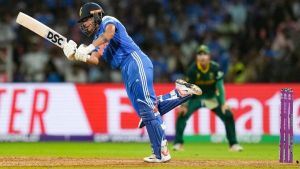
Samira Vishwas
Tezzbuzz|02-11-2025
Overview:
The pitch at Ninja Stadium (Bellerive Oval) is a slow and balanced surface that gradually favors batters as the game progresses.
After Australia’s dominant four-wicket win in the second T20I at the Melbourne Cricket Ground, the series now moves to Hobart, where both sides will lock horns at the picturesque Ninja Stadium, also known as Bellerive Oval. The five-match series stands at 1-0 in Australia’s favour after the first game was washed out in Canberra.
India’s batting order stumbled at the MCG, managing just 125 runs before being bowled out in 18.4 overs. Despite a resilient 68 from Abhishek Sharma and a fighting 35 from Harshit Rana, the visitors were unable to handle Australia’s disciplined attack, led by Josh Hazlewood’s 3/13. Mitchell Marsh and Travis Head then guided the home side to a comfortable victory in 13.2 overs.
As the action shifts to Hobart, both teams will be eager to make early adjustments. The Ninja Stadium’s surface and compact dimensions promise a fresh challenge — one where temperament, shot selection, and adaptability will be key.
India’s Squad for T20I Series against Australia
Suryakumar Yadav (c), Shubman Gill (vc), Abhishek Sharma, Tilak Varma, Nitish Kumar Reddy, Shivam Dube, Axar Patel, Jitesh Sharma (wk), Varun Chakravarthy, Jasprit Bumrah, Arshdeep Singh, Kuldeep Yadav, Harshit Rana, Sanju Samson (wk), Rinku Singh, Washington Sundar.
Australia’s Squad for T20I Series against India
Mitchell Marsh (c), Sean Abbott (games 1–3), Xavier Bartlett, Mahli Beardman (games 3–5), Tim David, Ben Dwarshuis (games 4–5), Nathan Ellis, Josh Hazlewood (games 1–2), Glenn Maxwell (games 3–5), Travis Head, Josh Inglis (wk), Matthew Kuhnemann, Mitchell Owen, Josh Philippe (wk), Matthew Short, Marcus Stoinis, Tanveer Sangha
India’s Probable XI against Australia for the 3rd T20I
Shubman Gill, Abhishek Sharma, Suryakumar Yadav (C), Tilak Varma, Sanju Samson (WK), Shivam Dube, Axar Patel, Varun Chakravarthy, Harshit Rana, Kuldeep Yadav, Jasprit Bumrah
Australia’s Probable XI against India for the 3rd T20I
Mitchell Marsh (C), Travis Head, Josh Inglis, Tim David, Josh Philippe (WK), Glenn Maxwell, Mitchell Owen, Xavier Bartlett, Nathan Ellis, Matthew Kuhnemann, Mahli Beardman
Bellerive Oval – Key Details of the Stadium
Bellerive Oval is a renowned cricket and Australian rules football venue situated in Bellerive, Hobart, Tasmania. Established in 1914, it can accommodate around 19,500 spectators, making it the second-largest stadium in the state. The ground serves as the home venue for the Tasmanian Tigers and Hobart Hurricanes and has hosted international matches since the late 1980s. Featuring stands like the Ricky Ponting Stand and David Boon Stand, the stadium overlooks the Derwent River. Its slow, batting-friendly pitch and scenic setting make it one of Australia’s most picturesque and balanced cricketing venues.
What is the Pitch Like at Bellerive Oval?
The pitch at Ninja Stadium (Bellerive Oval) is a slow and balanced surface that gradually favors batters as the game progresses. Early on, seamers get some assistance with swing and movement, but the pace and bounce reduce over time, making shot timing crucial. The average first innings score here ranges between 158 and 160, with teams batting first winning about 51.9% of matches. Fast bowlers remain effective with the new ball, while off spinners often struggle for turn. Overall, it’s a surface where patience, smart bowling variations, and calculated batting efforts determine success rather than outright aggression.
Key T20 Stats & Records at Bellerive Oval
- Highest Team Total: 213/4 by Australia against England
- Average First Innings Score: Around 158–160, suggesting a moderately high scoring wicket.
- Win Ratio: Teams batting first have won about 51.9% of matches, slightly favoring sides that opt to set a total
- Bowling Trends: Fast bowlers have the best averages and strike rates, while off spinners tend to concede more runs per wicket
- Pitch Behavior: Starts with some movement for pacers before slowing down considerably, favoring batters in the second half of the innings
- Batting Style: Encourages patient, calculated batting with well timed strokes rather than relentless power hitting
These records underline Bellerive Oval as a balanced ground offering early assistance to bowlers but generally rewarding batsmen who play with control and adaptability as the innings progresses.
IND vs AUS: Weather Forecast – Will Rain Play a Role?
Hobart’s weather on match day is expected to be mild and clear, with temperatures hovering between 11°C and 20°C. The morning could see some cloud cover, but the skies are likely to clear by the evening. Light northeasterly winds and moderate humidity levels around 60–65% will make for comfortable playing conditions.
The chance of rain remains very low, ensuring a full game of cricket. Dew may play a role later in the evening, which could make gripping the ball tricky for spinners and bowlers operating at the death. Captains winning the toss might prefer to bat first, as chasing can become challenging if the pitch slows down further under lights.
IND vs AUS: Pitch Advantage for Which Side?
The surface at Ninja Stadium provides an even playing field, but the first few overs are crucial. Seamers who hit hard lengths and exploit early movement can make an impact, while set batters can accelerate later due to the true bounce. Spinners may find limited purchase, though variations and tight lines can still yield results.
Teams batting first often find success by posting totals in the 160–180 range, which tend to be competitive on this ground. For India, early partnerships and disciplined bowling in the powerplay will be essential to challenge Australia’s strong top order. Meanwhile, the hosts will look to extend their momentum and take advantage of the home familiarity and slightly slower conditions.
FAQs – Pitch Report for Bellerive Oval, Hobart
Q1: What is the pitch report for the Bellerive Oval?
The pitch at Bellerive Oval is slow and balanced, offering early movement for pacers before settling into a batting-friendly surface as the match progresses.
Q2: What is India’s record at the Bellerive Oval in T20Is?
India will be playing their first T20I at Bellerive Oval on November 2. In ODIs, they have played five matches here, winning three of them.

Jemimah Rodrigues, India Women finally reveal team anthem, coaches join in - watch

'What God has written for you.. ': Deepti Sharma's emotional message following World Cup triumph

Of Monsoons, manifestation and modesty: Lessons from a chaotic home World Cup

Shafali Verma Captain: Shafali Verma became the captain, got great news







